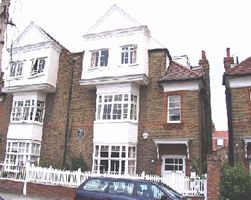William Butler Yeats in Bedford Park Chiswick
Yeats in Bedford Park
With the former residence of the poet William Butler Yeats up for sale, Chris Deering writes about the influence that the area had on his writings.
Far from being a footnote in his life, William Butler Yeats's time in Chiswick was actually a most important period in his development as an artist. In the second spell in the Bedford Park area Yeats composed what is his best known poem, the Lake Isle of Innisfree, met the woman who was to be the object of his unrequited passion and made the acquaintance of luminaries of the artistic world such as Oscar Wilde, George Bernard Shaw and William Morris.
The Yeats family had been forced to adopt an itinerant lifestyle after the decision of John Butler Yeats, William's father, to abandon law for his art. They moved between Sligo, Dublin and London with increasing pressure on their household income as their father's artistic career failed to pay dividends and their lands in Ireland saw a reduction in rents due to the ongoing political upheaval.
They first came to London in 1867 living in Edith Villas in Fulham. W B Yeats attended Godolphin School in Iffley Road (now the girl's school Godolphin and Latymer). The reputation it had in those days bore no relation to its present day eminence. Yeats described it as having 'the rough manners of a cheap school' and the boys were the sons of those 'who had failed or were at the outset of their career."
In 1879 they made their first move to Bedford Park, taking a two-year lease on 8 Woodstock Road. The area hadn't fully taken shape at this point and probably still resembled a building site. Many people would still have described this part of London as Hammersmith. It should not be assumed that residence in Bedford Park had the cachet that it has now.
The area was considered cheap and the Yeats themselves had difficult paying the local butchers. By the late eighties it had become established as an affordable location for the less well off artist. Yeats biographer Roy Foster said, " Bedford Park demonstrated that by the 1880s aestheticism, long a butt for satire, was established enough to have moved to the suburbs: a word rejected by the inhabitants, who preferred the idea of a village or a colony."
 After returning to Ireland for a period the family came back to London in 1887 and moved to 3 Blenheim Road in Bedford Park in March 1888. The rent on the house was £50 a year, which is somewhat below what it would cost to let now. Yeats had a study in the house on the ceiling of which he painted signs of the zodiac and his father painted a map of Sligo on the wall. Unfortunately they are no longer there
After returning to Ireland for a period the family came back to London in 1887 and moved to 3 Blenheim Road in Bedford Park in March 1888. The rent on the house was £50 a year, which is somewhat below what it would cost to let now. Yeats had a study in the house on the ceiling of which he painted signs of the zodiac and his father painted a map of Sligo on the wall. Unfortunately they are no longer there
Perhaps the most significant event of Yeats's life occurred at this house when on 30th January 1889 Maud Gonne was a visitor. Yeats said of the event, 'the troubling of my life began.' He was immediately taken by Maud Gonne and went on to propose to her several times. She always said no but Yeats held out hope for many years and she became an important influence on his writing. In the end her Irish nationalism led her to wed the more dashing Major John MacBride who was executed by the British in 1916.
The genesis of Lake Isle of Innisfree is described by his sister Lily. "In Bedford Park one evening … Willy bursting in having just written, or not even written down but just having brought forth 'Innisfree', he repeated it with all the fire of creation of his youth."
Although the phenomenal popularity of the poem was later to become a source of irritation to Yeats, it remains possibly the best known poem in the English language.
The Yeats family fitted in well with the artistic and political life of Bedford Park which included artists, aesthetes, occultists, retired army officers and anarchists, the latter immortalised by G K Chesterton.
Within walking distance of his house there were leading experts on the Celtic folklore that was having an increasingly important influence on his work and in Hammersmith there was the studio of William Morris, of whom Yeats was a great admirer.
The house remained in the family until 1902 when they moved back to Ireland and now bears a blue plaque. In the intervening years the area may have ceased to be the centre of artistic endeavour that it used to be, and with the local theatre under threat of closure, another part of this legacy is in danger of being lost, but in many ways it retains a distinct character that Yeats may well still recognise. Quite would he would have made of the current price of his old residence is difficult to imagine.